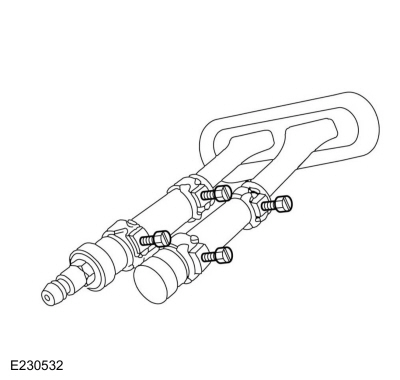Lincoln Navigator: Climate Control System - General Information / Heater Core Leak Check. General Procedures
Inspection
-
NOTE: A coolant leak in the heater hose could follow the heater core tube to the heater core and appear as a leak in the heater core.
Inspect for evidence of coolant leakage at the heater hose to heater core attachments.
-
NOTE: Spring-type clamps are installed as original equipment. Installation and overtightening of nonspecified clamps can cause leakage at the heater hose connection and damage the heater core.
Check the integrity of the heater hose clamps.
-
Drain the coolant from the cooling system. Refer to
Cooling System Draining, Filling, and Bleeding procedure in Group 303.
-
Disconnect the heater hoses from the heater core.
-
Install a short piece of heater hose, approximately 101 mm (4 in) long on each heater core tube.
-
Fill the heater core and heater hoses with water and
install the plug (221373) and the adapter (221374) from the Pressure
Test Kit. Secure the heater hoses, plug and adapter with hose clamps.
 |
-
Attach the pump and gauge assembly from the Pressure Test Kit to the adapter.
-
Access the Pressure Test Kit Service Tools.
Refer to: Climate Control Tools and Equipment (412-00 Climate Control System - General Information, General Procedures).
-
Access the Pressure Test Kit Service Tools.
-
Close the bleed valve at the base of the gauge. Pump 138 kPa (20 psi) of air pressure into the heater core.
-
Observe the pressure gauge for a minimum of 3 minutes.
-
If the pressure drops, check the heater hose connections
to the heater core tubes for leaks. If the heater hoses do not leak,
replace the heater core. Refer to the appropriate heater core removal
and installation procedure in Group 412-00.
 Fluorescent Dye Leak Detection. General Procedures
Fluorescent Dye Leak Detection. General Procedures
Leak detection
Review next note for important refrigerant system dye information.
NOTE:
Fluorescent refrigerant system dye is added to the
refrigerant system at the factory to assist in refrigerant system leak
diagnosis using a Rotunda-approved UV
lamp...
 Refrigerant Identification Testing. General Procedures
Refrigerant Identification Testing. General Procedures
Activation
NOTE:
Use Refrigerant Identification Equipment to identify
gas samples taken directly from the refrigeration system or storage
containers prior to recovering or charging the refrigerant system...
Other information:
Lincoln Navigator 2018-2025 Workshop Manual: Rear Drive Halfshafts. Diagnosis and Testing
Preliminary Inspection Visually inspect the CV joints, housing, boots, and clamps for obvious signs of mechanical damage. If an obvious cause for an observed or reported concern is found, correct the cause (if possible) before proceeding to the next step If the cause is not visually evident, verify the symptom and REFER to Symptom Chart: NVH...
Lincoln Navigator 2018-2025 Workshop Manual: Paintwork Defects and Damage. General Procedures
Materials Name Specification Motorcraft® Acid NeutralizerZC-1-A - Motorcraft® Alkaline NeutralizerZC-2-A - Repair NOTE: Refinishing - Environmental Damage WARNING: Before beginning any service procedure in this manual, refer to health and safety warnings in section 100-00 General Information...
Categories
- Manuals Home
- 4th Gen Lincoln Navigator Service Manual (2018 - 2025)
- All Terrain Control Module (ATCM). Removal and Installation
- SYNC Module [APIM]. Removal and Installation
- Remote Function Actuator (RFA) Module. Removal and Installation
- Identification Codes. Description and Operation
- Transmission Fluid Level Check. General Procedures
Diagnostic Methods. Description and Operation
This document provides critical diagnostic knowledge required for successful repair outcomes. It identifies technical competencies expected by users of this manual.
Ford Diagnostic Assumptions
Ford diagnostics assume the vehicle concern described by the test title is currently present. Exceptions to this rule are noted in each test. Do not replace modules or other components as directed by a diagnostic if the concern is not present at the time of testing.
